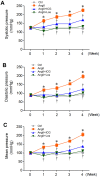An essential role for Wnt/β-catenin signaling in mediating hypertensive heart disease
- PMID: 29895976
- PMCID: PMC5997634
- DOI: 10.1038/s41598-018-27064-2
An essential role for Wnt/β-catenin signaling in mediating hypertensive heart disease
Abstract
Activation of the renin-angiotensin system (RAS) is associated with hypertension and heart disease. However, how RAS activation causes cardiac lesions remains elusive. Here we report the involvement of Wnt/β-catenin signaling in this process. In rats with chronic infusion of angiotensin II (Ang II), eight Wnt ligands were induced and β-catenin activated in both cardiomyocytes and cardiac fibroblasts. Blockade of Wnt/β-catenin signaling by small molecule inhibitor ICG-001 restrained Ang II-induced cardiac hypertrophy by normalizing heart size and inhibiting hypertrophic marker genes. ICG-001 also attenuated myocardial fibrosis and inhibited α-smooth muscle actin, fibronectin and collagen I expression. These changes were accompanied by a reduced expression of atrial natriuretic peptide and B-type natriuretic peptide. Interestingly, ICG-001 also lowered blood pressure induced by Ang II. In vitro, Ang II induced multiple Wnt ligands and activated β-catenin in rat primary cardiomyocytes and fibroblasts. ICG-001 inhibited myocyte hypertrophy and Snail1, c-Myc and atrial natriuretic peptide expression, and abolished the fibrogenic effect of Ang II in cardiac fibroblasts. Finally, recombinant Wnt3a was sufficient to induce cardiomyocyte injury and fibroblast activation in vitro. Taken together, these results illustrate an essential role for Wnt/β-catenin in mediating hypertension, cardiac hypertrophy and myocardial fibrosis. Therefore, blockade of this pathway may be a novel strategy for ameliorating hypertensive heart disease.
Conflict of interest statement
The authors declare no competing interests.
Figures









Similar articles
-
Wnt/β-catenin regulates blood pressure and kidney injury in rats.Biochim Biophys Acta Mol Basis Dis. 2019 Jun 1;1865(6):1313-1322. doi: 10.1016/j.bbadis.2019.01.027. Epub 2019 Jan 30. Biochim Biophys Acta Mol Basis Dis. 2019. PMID: 30710617 Free PMC article.
-
Klotho inhibits angiotensin II-induced cardiomyocyte hypertrophy through suppression of the AT1R/beta catenin pathway.Biochem Biophys Res Commun. 2016 Apr 29;473(2):455-61. doi: 10.1016/j.bbrc.2016.03.029. Epub 2016 Mar 10. Biochem Biophys Res Commun. 2016. PMID: 26970306
-
Role of RAS/Wnt/β-catenin axis activation in the pathogenesis of podocyte injury and tubulo-interstitial nephropathy.Chem Biol Interact. 2017 Aug 1;273:56-72. doi: 10.1016/j.cbi.2017.05.025. Epub 2017 Jun 2. Chem Biol Interact. 2017. PMID: 28578904
-
Renin-angiotensin system, hypertrophy and gene expression in cardiac myocytes.J Mol Cell Cardiol. 1999 May;31(5):949-70. doi: 10.1006/jmcc.1999.0934. J Mol Cell Cardiol. 1999. PMID: 10336836 Review.
-
Antagonism of the renin-angiotensin system, hypertrophy and gene expression in cardiac myocytes.Methods Find Exp Clin Pharmacol. 1999 Jun;21(5):363-74. doi: 10.1358/mf.1999.21.5.541915. Methods Find Exp Clin Pharmacol. 1999. PMID: 10420393 Review.
Cited by
-
Hypertrophy of human embryonic stem cell-derived cardiomyocytes supported by positive feedback between Ca2+ and diacylglycerol signals.Pflugers Arch. 2019 Aug;471(8):1143-1157. doi: 10.1007/s00424-019-02293-0. Epub 2019 Jun 28. Pflugers Arch. 2019. PMID: 31250095 Free PMC article.
-
CXCR4 induces podocyte injury and proteinuria by activating β-catenin signaling.Theranostics. 2022 Jan 1;12(2):767-781. doi: 10.7150/thno.65948. eCollection 2022. Theranostics. 2022. PMID: 34976212 Free PMC article.
-
Lcz696 Alleviates Myocardial Fibrosis After Myocardial Infarction Through the sFRP-1/Wnt/β-Catenin Signaling Pathway.Front Pharmacol. 2021 Sep 2;12:724147. doi: 10.3389/fphar.2021.724147. eCollection 2021. Front Pharmacol. 2021. PMID: 34539406 Free PMC article.
-
Wnt Signaling Inhibitors as Therapeutic Approach in Ischemic Heart Disease.Molecules. 2024 Dec 17;29(24):5958. doi: 10.3390/molecules29245958. Molecules. 2024. PMID: 39770047 Free PMC article. Review.
-
Development and Validation of a Novel Nomogram to Predict the Risk of Intervertebral Disc Degeneration.Mediators Inflamm. 2022 Sep 10;2022:3665934. doi: 10.1155/2022/3665934. eCollection 2022. Mediators Inflamm. 2022. PMID: 36123994 Free PMC article. Clinical Trial.
References
Publication types
MeSH terms
Substances
Grants and funding
LinkOut - more resources
Full Text Sources
Other Literature Sources
Medical
Research Materials
Miscellaneous

